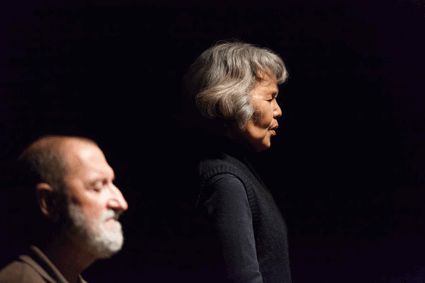innovative diffusion
felicity clark: julian day & luke jaaniste, super critical mass, aurora festival

Super Critical Mass, Aura
photo Alex Wisser
Super Critical Mass, Aura
THE IDEA OF CRITICAL MASS CAN DENOTE A COLLECTIVE ACTION THAT IS BENEFICIAL TO ALL, REGARDLESS OF INDIVIDUAL CONTRIBUTION. BUT IT ALSO IMPLIES A CERTAIN INERTIA: A CREATIVE BEAST THAT LURES YOU INTO ITS MACHINATIONS AND USES YOUR PERCEPTION AS A SORT OF ARTISTIC PLASMA.
Super Critical Mass, a sensuous and atmospheric exploration of sound devised by Julian Day and Luke Jaaniste, featured at the opening event of Aurora Festival of Living Music, Aura. Their project had aired in Australian cities and UK festivals already so it had the expected weight of success to get the ball rolling for the Aurora Festival of Living Music.
Blacktown Arts Centre was piqued for pomp with food platters, booze and an edgy photographic exhibition documenting the back-yard lives of beer-guzzlers, corrugated iron fences and gaming consoles depressing sunken sofas. There was no doubt we were in Western Sydney, where high and low culture meet, and proud of it. An appropriate mood was set for Super Critical Mass: a mixing pot of amateurism and professionalism, performance and authentic living.
The composer-sound artists had set out to explore ambience, spatialised sound and the complexities that emerge from simple patterns and actions. Vocalists from Singing Streets and Simply Voices combined in a sort of algorithmic, wordless chant in a darkened room. Each time singers wished to contribute they would stand up and make an extended vowel sound for as long as desired and then sit down again. Staring straight ahead and uniformly dressed, the group operated as a mass of individuals rather than a team. Each participant appeared to be contributing at random intervals in terms of time and pitch. Whether or not any pattern was observable by the audience seemed less important than the mass of sound generated by the group.
The audience was invited to cohabit the performance space, walking freely in between singers, getting up close, contributing percussion with our heels. While the concept was good and the execution very real, it went on for too long. And just when we the critical masses thought it was done, they did it all again…with harmonicas.

Super Critical Mass, Aura
photo Alex Wisser
Super Critical Mass, Aura
In the second iteration of Super Critical Mass, each of the singers played mouth organs in place of voices. Long tones at seemingly random intervals were layered to evoke the memory of a trampled piano accordion, long after the bullies at the circus had gone in search of the next bearded lady. In this second round of chaotic drone combinations the performers were not locked to their fixed locations in the room. Rather than standing and then sitting to frame each utterance, the performers were free to roam, slowly, and to engage us and each other eye to eye. Coming after the vocal Turing Machine of the first part, this felt connected, like the smartphone generation. Perhaps the harmonica set was more successful than the vocal round, but by this time the concept had out-warbled its welcome and I was left feeling trapped in a vortex of expiring wheezes: a place where irritating ringtones go to die.
Super Critical Mass was highly affective. The sounds generated certainly had an effect on me and others. It challenged my concept of chamber music, community and interactivity. This critical mass swept me along but what would it have taken, I wonder, to make me join in?
Aurora Festival of Living Music: Super Critical Mass, composers Julian Day and Luke Jaaniste, performers Singing Streets and Simply Voices; Blacktown Arts Centre, Sydney, May 4; www.auroranewmusic.com.au/
RealTime issue #109 June-July 2012 pg. web






